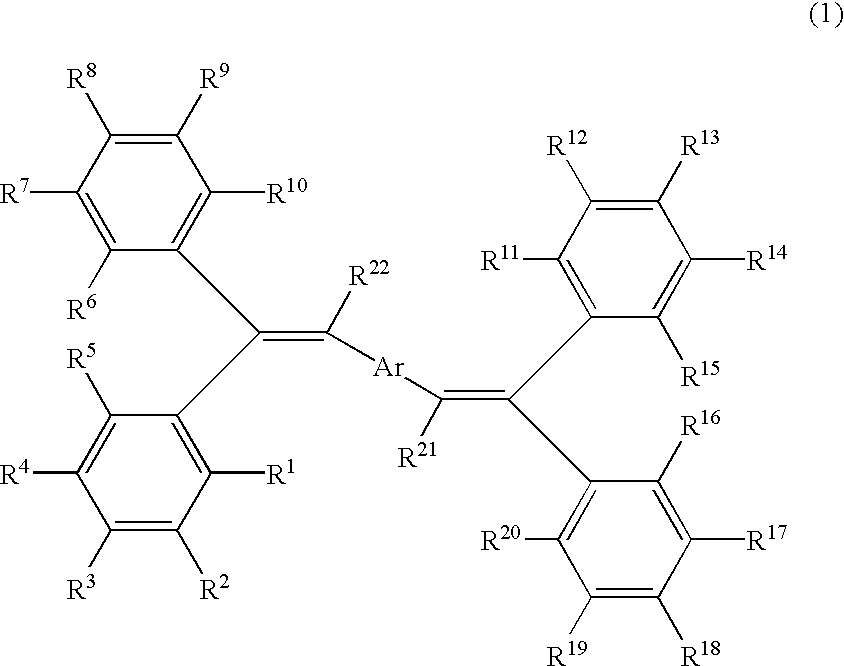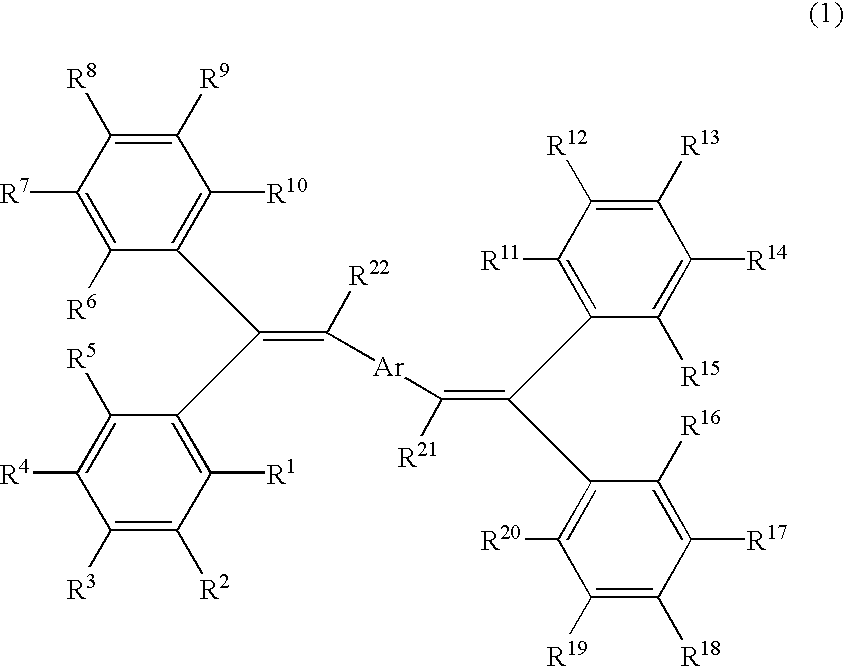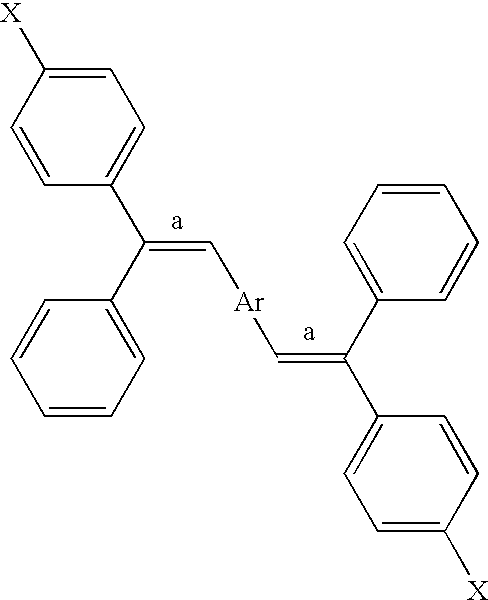Bis (diphenylvinyl) arene compound
a technology of diphenylvinyl and arene compound, which is applied in the field of arene compound, can solve the problems of insufficient reactivity such as polymerization, and achieve the effect of reducing the number of reactive elements
- Summary
- Abstract
- Description
- Claims
- Application Information
AI Technical Summary
Problems solved by technology
Method used
Image
Examples
example 1
Synthesis of 1,4-bis[2-(4-bromophenyl)-2-phenylethenyl]-2-(2-ethylhexyloxy)-5-methoxybenzene
Under an inert atmosphere, 4-bromobenzophenone (0.783 g, 3mmol), and 1,4-bis-(diethylphosphonomethyl)-2-(2-ethylhexyloxy)-5-methoxy benzene (0.660 g, 1.23 mmol) were dissolved in tetrahydrofuran (10 g). At room temperature, tetrahydrofuran (3.28 g) solution of tert-butoxy potassium (0.414 g, 3.69 mmol) was added dropwise for 5 minutes, and successively stirred for 3.5 hours. The reaction mixture was charged into water (100 ml) and neutralized with 5% sulfuric acid. After neutralization, ethyl acetate (250 ml) was added and the organic layer was partitioned. The organic layer was washed with water and dried over anhydrous sodium sulfate. The solvent was distilled off under reduced pressure, and the resultant raw product was purified by silica gel chromatography to give the desired product. (Yield: 0.86 g, 93%)
MS Spectrum: M+ 751.2, M+-C8H16 639.1. 1H-NMR(200 MHz / CDCl3) ä 0.78-1.05 ppm (m, 6H),...
example 2
Synthesis of 9,10-bis[2-(4-bromophenyl)-2-phenylethenyl]anthracene
Under an inert atmosphere, 4-bromobenzophenone (3.917 g, 15 mmol), and 9,10-bis-(diethylphosphonomethyl)anthracene (2.942 g, 6.15 mmol) were dissolved in tetrahydrofuran (40 g). At room temperature, tetrahydrofuran (16.38 g) solution of tert-butoxy potassium (2.070 g, 18.45 mmol) was added dropwise for 5 minutes, and successively stirred for 3.5 hours. The reaction mixture was charged into water (100 ml) and neutralized with 5% sulfuric acid. After neutralization, the crystal was filtrated and the dissolved in tetrahydrofuran (300 ml). Then, the solvent was partly distilled off under reduced pressure, and cooled to deposit crystal. The crystal was filtrated and dried to give the desired product. (Yield: 1.10 g, 26%)
MS Spectrum: M+ 693.1
example 3
Synthesis of 1,4-bis[2-(4-bromophenyl)-2-phenylethenyl]-2-(3,7-dimethyloctyl)-5-methylbenzene
Under an inert atmosphere, 4-bromobenzophenone (2.611 g, 10 mmol), and 1,4-bis(diethylphosphonomethyl)-2-(3,7-dimethyloctyl)-5-methyl benzene (2.184 g, 4.10 mmol) were dissolved in tetrahydrofuran (30 g). At room temperature, tetrahydrofuran (10.92 g) solution of tert-butoxy potassium (1.380 g, 12.30 mmol) was added dropwise for 5 minutes, and successively stirred for 3.5 hours. The reaction mixture was charged into water (200 ml) and neutralized with 5% sulfuric acid. After neutralization, ethyl acetate (250 ml) was added and the organic layer was partitioned. The organic layer was washed with water and dried over anhydrous sodium sulfate. The solvent was distilled off under reduced pressure, and the resultant raw product was purified by silica gel chromatography to give the desired product. (Yield: 1.34 g, 44%)
MS Spectrum: M+ 747.2 and M+-C9H18 621.1. 1H-NMR(200 MHz / CDCl3) ä 0.55-0.93 ppm ...
PUM
 Login to View More
Login to View More Abstract
Description
Claims
Application Information
 Login to View More
Login to View More - R&D Engineer
- R&D Manager
- IP Professional
- Industry Leading Data Capabilities
- Powerful AI technology
- Patent DNA Extraction
Browse by: Latest US Patents, China's latest patents, Technical Efficacy Thesaurus, Application Domain, Technology Topic, Popular Technical Reports.
© 2024 PatSnap. All rights reserved.Legal|Privacy policy|Modern Slavery Act Transparency Statement|Sitemap|About US| Contact US: help@patsnap.com










